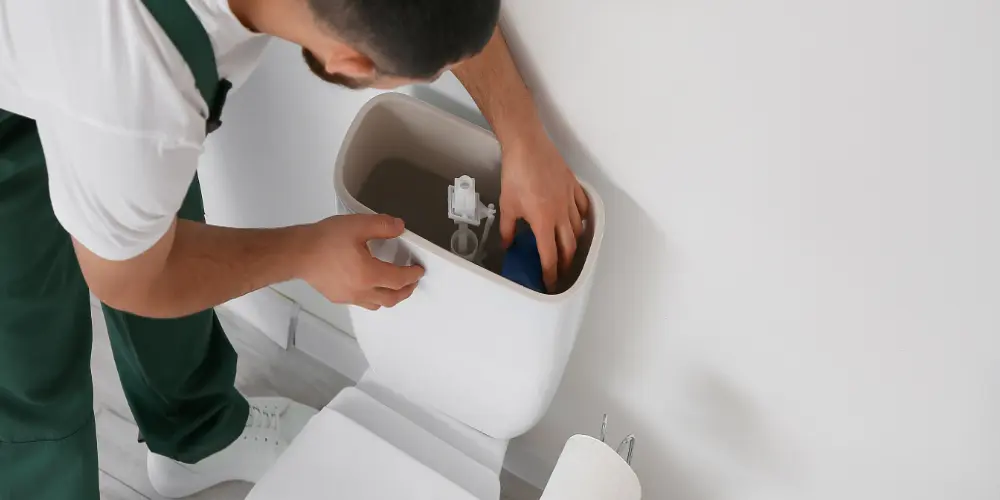Is your toilet running? Then you’d better catch it!
A constantly running toilet isn’t just annoying — it can waste hundreds of gallons of water every single day. But you don’t have to live with it; adjusting your toilet fill valve is a simple DIY fix that can save you gallons of water — and maybe even some bragging rights around the house.
Whether your toilet runs nonstop, flushes weakly, or has an insufficient water level, learning how to adjust your fill valve can save water, money, and frustration.
Remember: little fixes now prevent big problems later. And your toilet will thank you — in its own quiet, efficient way.
What Is a Toilet Fill Valve?
The fill valve is the tall part inside your toilet tank (usually on the left side) that refills the water after every flush. When it’s working right, it:
- Refills the tank quickly
- Stops the flow once the tank is full
- Keeps water levels consistent
When it’s not working right, you might notice:
- Water running constantly (that’s money literally going down the drain)
- Weak or incomplete flushes
- Hissing sounds from the tank
- Water levels that are too high or too low
Tools and Materials You’ll Need
Before starting, gather a few basics:
- Flathead screwdriver (some valves need this)
- Adjustable wrench (optional)
- Towel or sponge
- Bucket for easier cleanup
Most adjustments require just your hands, so you can leave your toolkit in the garage.
Step-by-Step: Adjusting Your Fill Valve
Step 1: Turn Off the Water Supply
- Find the shut-off valve behind or under your toilet and turn it clockwise until it stops.
- Flush once to drain most of the water.
- Use a towel or sponge to soak up the remaining water.
Step 2: Identify Your Fill Valve Type
Every toilet has a fill valve. Yours might be:
- Float cup valve: The most common, with a cylindrical float sliding up and down.
- Float ball valve: The old-school one with a ball on a metal rod.
- Internal float valve: A newer, compact design with the float hidden inside.
Different styles adjust slightly differently, so it helps to know your type before you begin.
Step 3: Adjust the Water Level
For Float Cup Valves
- Find the adjustment rod or screw on top of the valve.
- Pinch the metal clip or turn the screw.
- Slide the float up to raise the water level and down to lower it.
- Aim for about 1 inch below the overflow tube.
For Float Ball Valves
- Find the screw where the float arm meets the valve.
- Turn the screw clockwise to lower the level, counterclockwise to raise it.
- You can also gently bend the arm downward or upward — but go easy! You’re fixing a toilet, not sculpting metal art.
For Internal Float Valves
- Look for a dial or pinch clip on the valve head.
- Turn clockwise to lower the level, counterclockwise to raise it.
That 1-inch mark below the overflow tube is your sweet spot — enough water for a strong flush without overfilling.
Step 4: Test the Adjustment
- Turn the water back on by turning the shut-off valve counterclockwise and watching the tank fill up.
- The water should stop at the correct level on its own. If it keeps running or stops too soon, tweak again.
- Flush a few times to make sure everything’s working correctly. The tank should refill and stop within a minute or so.
Step 5: Fine-Tune as Needed
If your toilet still acts up:
- Check the flapper: Make sure the rubber seal at the bottom of the tank closes tightly.
- Check the overflow tube: Water shouldn’t constantly run into it.
- Check the refill tube: It should direct water into the overflow tube, not beside it.
Fine-tuning here can make all the difference.
When to Replace Your Fill Valve
Sometimes, even the best DIY fix won’t work. Replace your fill valve if:
- It’s more than 10 years old
- You see cracks or mineral buildup
- Adjustments don’t help
- The float sticks or moves slowly
- Water leaks from the base
New fill valves are inexpensive ($10–$30) and easy to install. Plus, modern ones are more efficient, quieter, and longer-lasting.
Why It Matters: Water Conservation
According to the EPA, a running toilet can waste over 200 gallons of water per day — that’s like leaving a garden hose running all day!
Keeping your toilet in top shape helps:
- Lower your water bill
- Conserve local water supplies
- Reduce stress on city systems
- Support sustainable living
FAQs: Adjusting a Toilet Fill Valve
Q: How often should I check my toilet fill valve?
Inspect your fill valve every six months. Listen for running water and check that the tank refills properly after flushing. Catching issues early prevents water waste.
Q: Why does my toilet run intermittently?
Intermittent running usually indicates a worn flapper rather than a fill valve problem. The flapper isn’t sealing completely, allowing water to leak slowly into the bowl. The fill valve then activates periodically to refill the tank.
Q: Can I adjust the fill valve without turning off the water?
You can make minor adjustments with the water on, but it’s messy and makes it harder to see what you’re doing. Turning off the water takes a few seconds, making the job cleaner and easier.
Q: What if the adjustment screw is stuck?
Mineral deposits can cause screws to seize. Apply a small amount of white vinegar to dissolve buildup, wait 15 minutes, and try again. If it still won’t move, replacing it may be your best option.
Q: Should the water level be the same in all toilets?
Water level requirements vary by toilet model. Always aim for about 1 inch below the overflow tube. Some high-efficiency toilets use less water and may have different specifications.
Q: How do I know if my fill valve is too old to adjust?
If the valve body shows cracks, heavy corrosion, or mineral buildup, or if adjustments don’t hold, replacing the valve is more practical than continually adjusting it.
Q: Will adjusting the fill valve affect flush power?
Yes. Setting the water level too low reduces flush effectiveness. Too high wastes water and may cause overflow issues. The 1-inch-below-overflow guideline provides optimal performance.
Q: Can hard water damage my fill valve?
Hard water accelerates mineral buildup on valve components, potentially causing sticking or failure. Regular cleaning and eventual replacement extend valve life in hard water areas.


